Table of Contents
- The cost of waterproofing a private house (price per m2)
- Waterproofing of the floor in a private house
- Waterproofing of walls and foundations of a private house
- Waterproofing in the basement of a private house
- Examples of waterproofing the basement from the outside
- Waterproofing a private house with your own hands
- To order waterproofing of a private house and cottage
Moisture and water — are the main enemy of suburban housing. It is able to penetrate into the building material and causes damage, leaks, and the formation of fungus on the walls and floor. Such damages negatively affect the interior decoration of the premises and the health of its residents. Waterproofing a private house — is not a luxury, but an objective necessity. To create a reliable structure, it is important to use high-quality materials tested by experts in the construction industry.
All elements of the building located underground (under level 0), such as the foundation, socle or basement walls, and other elements of a private structure, are subject to mandatory protection and waterproofing. Also, waterproofing should be applied to such structures as roofs, balconies, and terraces. Enhanced protection is mandatory in areas of the living space most exposed to contact with water:
- bathroom;
- kitchen;
- public bathroom and laundry.
It is in these places that the decoupling of water pipes is concentrated, and the walls often come into contact with water. It is quite difficult to maintain a stable internal climate in the house also due to the close proximity to the ground, which increases humidity and freezing.
At the design stage, it is recommended to mark places that require special attention:
- Walls of the house, below ground level;
- Vertical and horizontal seams of walls and floor;
- Foundation and foundation slab;
- The roof of the house, terrace, and balcony;
- Floor area throughout the house.

Horizontal
The purpose of horizontal waterproofing of the house and premises is to prevent the penetration of water and moisture from the soil. For example, the protection of the foundation slab of a private building refers to horizontal waterproofing. Horizontal insulation also prevents the capillary rise of moisture up the walls.
There are the following methods of horizontal protection and waterproofing during the construction of a private house:
- Pasted and surfaced
- Coating
- Liquid rubber
- Penetrating
- Mounted
- Injection
You can read more about the horizontal method in the article – “Horizontal waterproofing of the foundation: The technology of the installation and the materials necessary for this“.
Vertical
Vertical waterproofing is carried out to protect the foundation at the various stages of construction: the construction and operation of the premises. Vertical protection is designed so that moisture in the ground does not soak into the walls and does not destroy them.
The main methods of vertical waterproofing in a private house:
- Pasted and surfaced
- Coating
- Liquid rubber
- Penetrating
- Mounted
- Injection
Important: No matter what material the walls of your house are made of, concrete, brick or FBS blocks, without high-quality waterproofing, they will absorb moisture, which will lead to the formation of leaks, cracks, wet walls, mold and mildew.
You can read more about the vertical method in the article – “Vertical waterproofing: materials and methods of its installation“.
Further, you can familiarize yourself with the methods of waterproofing and the materials used in more detail.
Pasted and surfaced
When using pasted and surfaced technology, various pasting and surfaced roll materials, such as technoelast, isolate, or roofing material, are used as an insulating coating. This waterproofing is acceptable as an independent insulation system. To apply this type of insulation, a rigid base is required, which is pre-primed with a primer. It is used mainly on the surface of concrete, FBS blocks, and bricks. it is recommended to apply these materials in several layers.

Coating
The coating technology includes various materials applied to the surface by coating, using brushes, spatulas, and rollers. The most popular coating materials— are compositions based on bitumen and polyurethane
Bitumen mastics – In this case, bitumen mastic is used, reliably covering the walls of the foundation of a private building. Polyurethane mastics – The main component in such compositions is polyurethane. Bitumen and polyurethane compounds are applied to concrete or brick walls in 2-3 layers.

Liquid rubber
Liquid rubber – is applied to the foundation slab or walls by cold spraying, forming an elastic and seamless coating. The surface is covered with liquid rubber, which reliably protects it from moisture and freezing.
Waterproofing with liquid rubber is one of the most reliable ways to protect any foundation, as it forms an elastic and seamless coating with excellent adhesion to the surface.




Penetrating
It is distinguished by the use of cement mortars with an active chemical composition. The interaction of raw materials with concrete ensures the crystallization and formation of a dense layer. Penetrating waterproofing is suitable only for walls made of high-quality concrete without pores and voids. To apply compositions of this type, the foundation is pre-cleaned of dirt and wetted with water. After that, with the help of a sprinkler, a special solution is applied to it, penetrating into the structure of the concrete.
You can read more about the penetrating method in the article – “Penetrating waterproofing: A detailed description of its work on concrete, types of materials, and application technologies“

Mounted
The mounted technology includes various membranes, the principle of which is fastening to the surface using various pressure strips. The most popular material of this type is PVC membranes. PVC membranes are suitable for waterproofing walls made of concrete, bricks, blocks, and other bases.
You can read more about membrane waterproofing in the article – “Membrane waterproofing: Types of materials and methods of their installation“.
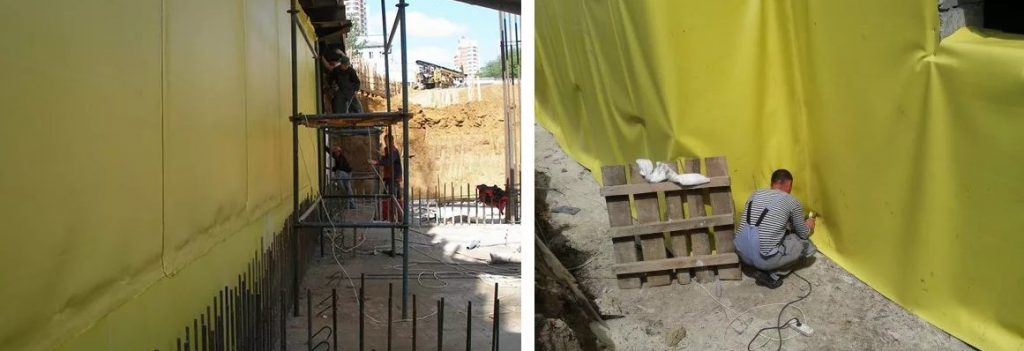
Injection
It assumes saturation of porous concrete by injection of a special chemical composition into drilled holes. Injectable compounds penetrate inside and begin to swell upon contact with water, thereby blocking the absorption of water from the soil. This method of waterproofing is used mainly as a part of measures to eliminate leaks in the basement when the house is already built and there is no access to the walls of the house from the outside. With the help of injection waterproofing, it is also possible to restore the missing cut-off waterproofing from inside the basement.


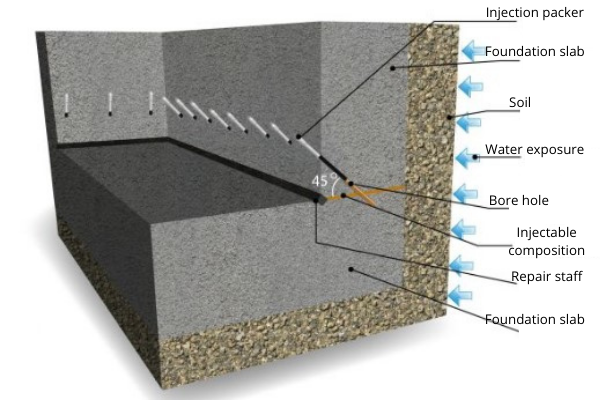
The cost of waterproofing a private house (price per m2)
The cost includes two components: payment for the work of craftsmen and the direct costs of the material used. If everything is pretty transparent with the first point, then not so much with the second one. The estimate for consumables depends on the area and type of waterproofing. Waterproofing of private houses involves many features that can affect the final calculation. All the details are clarified through companies specializing in this type of work. Here is a table with approximate prices for works per 1 m2:
| Description of works | Unit of measurement | Price in $ |
| Works on the arrangement of surfaced waterproofing | m2 | 10 |
| Works on the arrangement of PVC membrane | m2 | 20 |
| Works on the arrangement of polyurea | m2 | 30 |
| Works on the arrangement of mastic waterproofing | m2 | 8 |
| Works on the arrangement of liquid rubber by spraying | m2 | 8 |
| Works on the arrangement of liquid rubber manually | m2 | 10 |
| Works on the arrangement of cement-mineral double-component waterproofing | m2 | 20 |
| Works on the arrangement of polyurethane waterproofing | m2 | 20 |
| Applying the primer | m2 | 5 |
The prices of materials depend on the manufacturer and the quality of the products. Domestic systems will be cheaper than foreign products, but in most cases, they may be inferior in quality. The price of products also depends on the place of purchase, for example, on the market or from an unverified supplier, the material may cost less, but you risk running into counterfeit.
Calculator of the cost of waterproofing of private houses
Calculation of waterproofing cost
The total cost of waterproofing
Waterproofing of the floor in a private house
When it comes to waterproofing the floor in a private house, the choice of material for waterproofing depends on what you plan to do with the floor next. If you plan to fill the screed, then as waterproofing, you can use almost any waterproofing, from roll to mastic, since you will still press it with a screed. If you do not plan the further installation of the screed on the floor, then it is best to use waterproofing that works on negative water pressure, that is, pressure from the outside to the inside, for example, Polymer-mineral waterproofing.
Important: Bitumen mastics, surfaced membranes and PVC membranes do not work on negative water pressure, respectively, when applying these materials from inside the room, they should be pressed with a screed or a pressure wall.
When installing waterproofing of the floor, do not forget to lift it on the walls. The lifting height varies from 0.1m to 0.5m, and the higher you lift the protective layer on the walls, the better.
You can read more about the waterproofing of the floor and its installation in the following articles:
- Waterproofing of the basement floor of the house: Methods, technologies of installation, and materials
- Waterproofing of concrete floor in a private house – A detailed guide on how to do this work with your own hands and what materials to use at the same time
- How to make properly a basement recess below the sole of the foundation
Waterproofing of walls and foundations of a private house
When it comes to protecting the foundation from the penetration of moisture and water, then you can use a large palette of materials and waterproofing methods described earlier. Waterproofing of concrete foundations from water attention. Waterproofing of concrete foundations from water and groundwater is a very important topic that requires special attention. The most important thing— is not to save on this work, but to make reliable and high-quality waterproofing that will last a long time, and in the future will save you from unnecessary material expenses associated with dismantling the blind area, excavating the house, and replacing the waterproofing.
Recommendation: For high-quality waterproofing of the foundation of a private house, it is recommended to use waterproofing with the following characteristics: 1. Lack of seams – seams are always weak points; 2. Having 100% of adhesion to the surface – this ensures that the water will not walk and stagnate under the waterproofing coating; 3. Elasticity – the more elasticity the material has, the more reliable it is, since when the building shrinks or its dynamics, the material will stretch, and not diverge at the seams or crack. The most famous waterproofing material with similar characteristics is – Liquid rubber.
You can read more about waterproofing walls and foundations in the following articles:
- Waterproofing of basement and house walls from outside and inside – Methods, materials, prices, and technology
- Foundation waterproofing installation: Methods, materials, prices, and recommendations of specialists
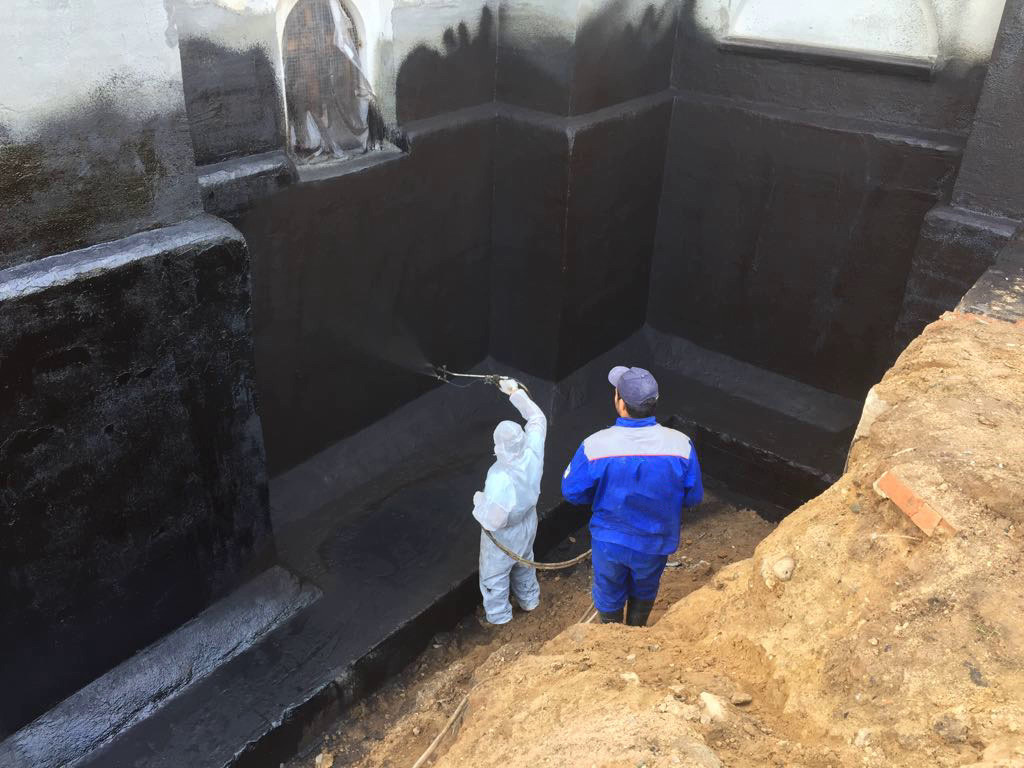
Waterproofing in the basement of a private house
Waterproofing the basement of the house and its protection from water is a complex issue that needs to be approached comprehensively. To the question of how to make waterproof a basement from the inside or outside, there is an unambiguous answer – from the outside.

When protecting your basement from the outside, you solve the root of the problem by protecting the concrete from moisture penetration and destruction. If for some reason it is impossible to protect your basement from the outside, there are several ways to waterproofing it from the inside:
- Injection waterproofing of a basement – is when special chemical compounds are injected into concrete, brick, or other foundation under pressure, penetrating into pores and voids, making them hydrophobic.
- Polymer-mineral elastic waterproofing – these compounds can be applied from the inside, as they work on negative water pressure.


You can read more about basement waterproofing in the following articles:
- Waterproofing of the basement from the inside: Methods, materials, and stages of work
- How to make waterproofing the basement properly from the outside
Examples of waterproofing the basement from the outside
For a more visual understanding of what the waterproofing of the foundation of a private house is, we show the portfolio of our teams and craftsmen:
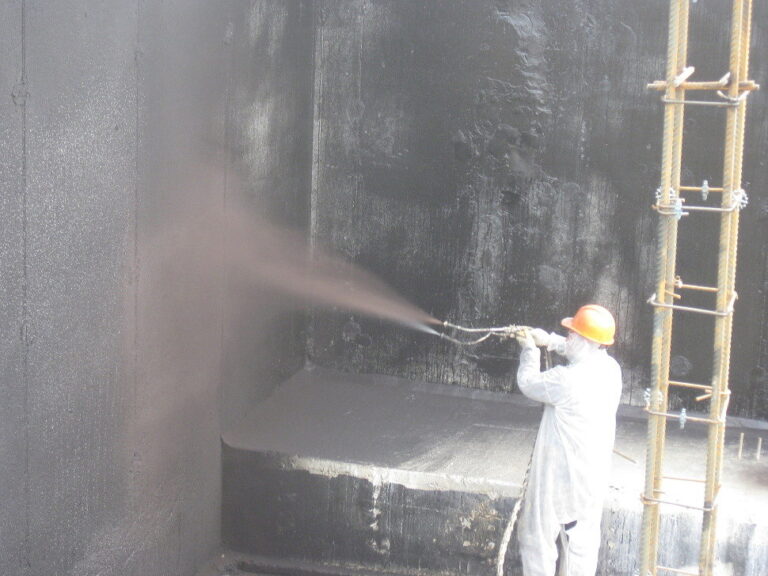
Waterproofing with liquid rubber:
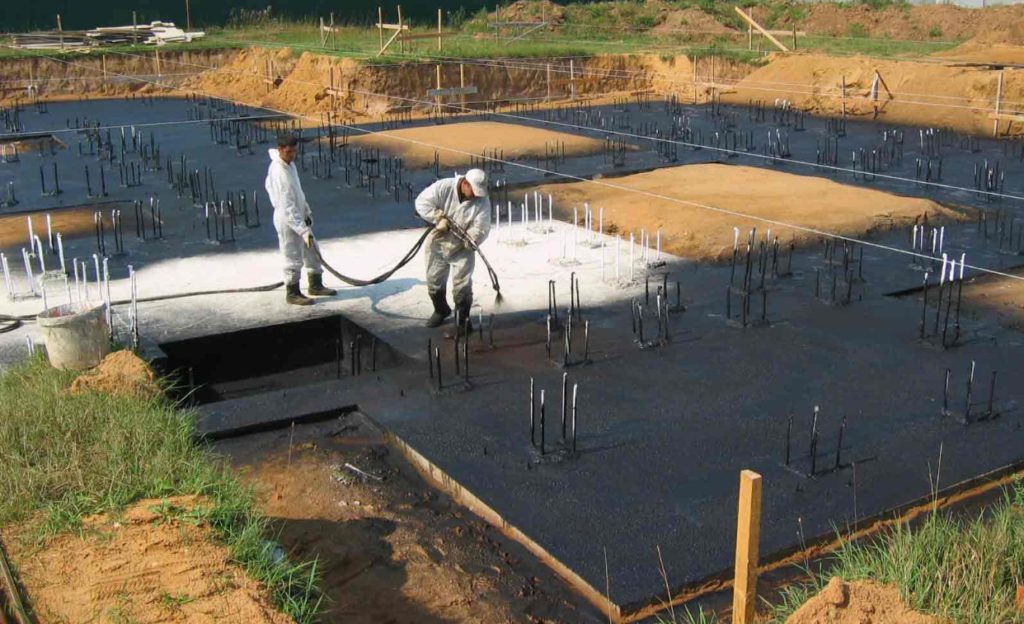


Surfaced waterproofing:
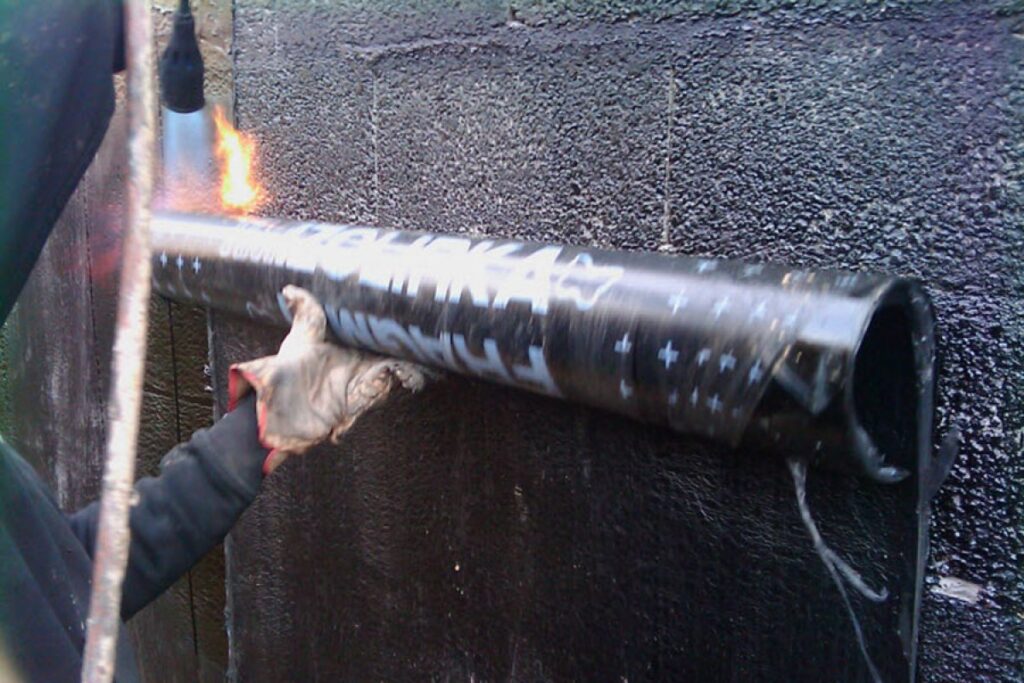

Waterproofing with PVC membrane:
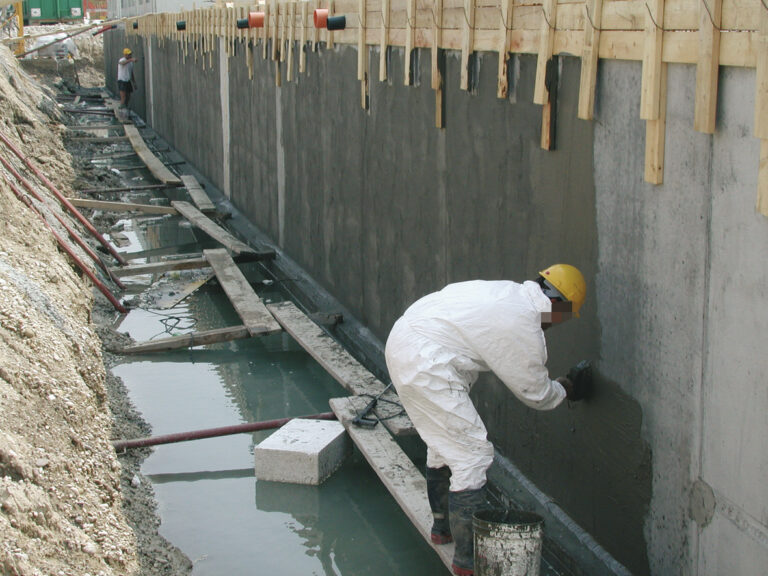
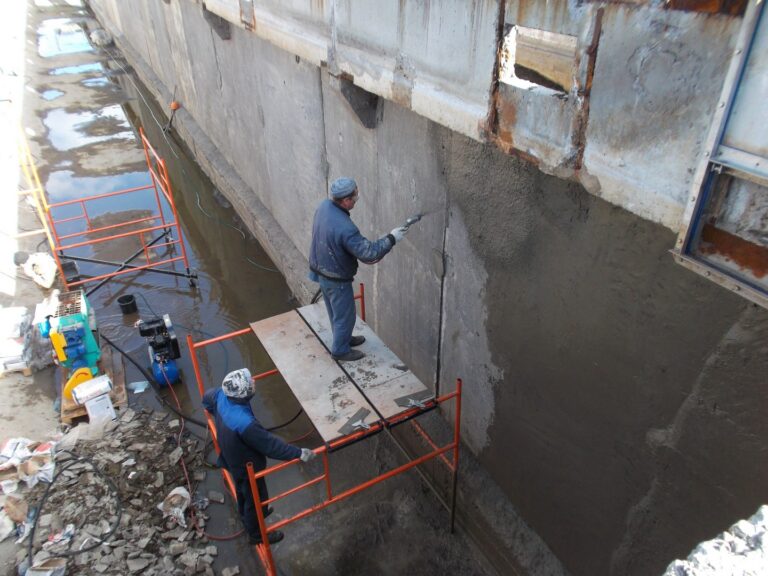
Each example of work reflects different technologies, and we provide additional information when discussing the exact parameters of the house.
Waterproofing a private house with your own hands
If you have a private house and you want to protect it from water penetration with your own hands, then you need to use one of the following methods:
- Coating insulation
- Pasted or surfaced insulation
These methods of protection can be applied independently and applied with your own hands without using special installations and equipment. At the same time, it is important to note that when working independently, you need to study carefully the manufacturer’s instructions for the installation of a particular material and strictly follow it, otherwise you risk the formation of leaks and expensive rework of the work done.
How to make waterproofing by yourself – Stages of work in a private cottage or house:
- Preparation – Clean the surface from dirt and dust. To do this, you can use the Kerher unit, brushes with metal bristles, rags, and cleaning cloth.
- Primer – apply a special primer to the surface to improve the adhesion of the main insulation material to the base.
- Insulation layer installation – Install waterproofing, strictly following the manufacturer’s instructions (for example, you can download such instructions in this article).
- Protection – Protect the work done from further mechanical damage.
What do we offer and recommendations?
In order to determine exactly which method of waterproofing and waterproofing material is best used, a waterproofing specialist should not easily hear from the customer how and what his foundation is made of, but come to the facility and look through the eyes of a specialist, since a simple person cannot always accurately convey all the necessary information.
In order to choose the right waterproofing as much as possible, we offer the departure of a waterproofing specialist (field engineer), to your facility, regardless of its location.
To perform waterproofing work, it is best to hire a professional company. The choice of an experienced specialized company provides the customer with:
- the guarantee for the services provided;
- an official contract with an indication of the cost and term;
- a detailed estimate before signing the contract;
- quality control system;
- the staff of the company with work experience;
- effective equipment;
- proven materials from well-known manufacturers.
To order waterproofing of a private house and cottage
In our production company, it is possible to order various types of waterproofing works for a private house “turnkey”. It is enough to contact the manager at the specified phone number or e-mail, discuss all the details of the upcoming work and make a detailed estimate. Our engineers will offer the most suitable material and tell you about the advantages and disadvantages of each of them. We will help to give your home warmth and protect it from the rough weather!









